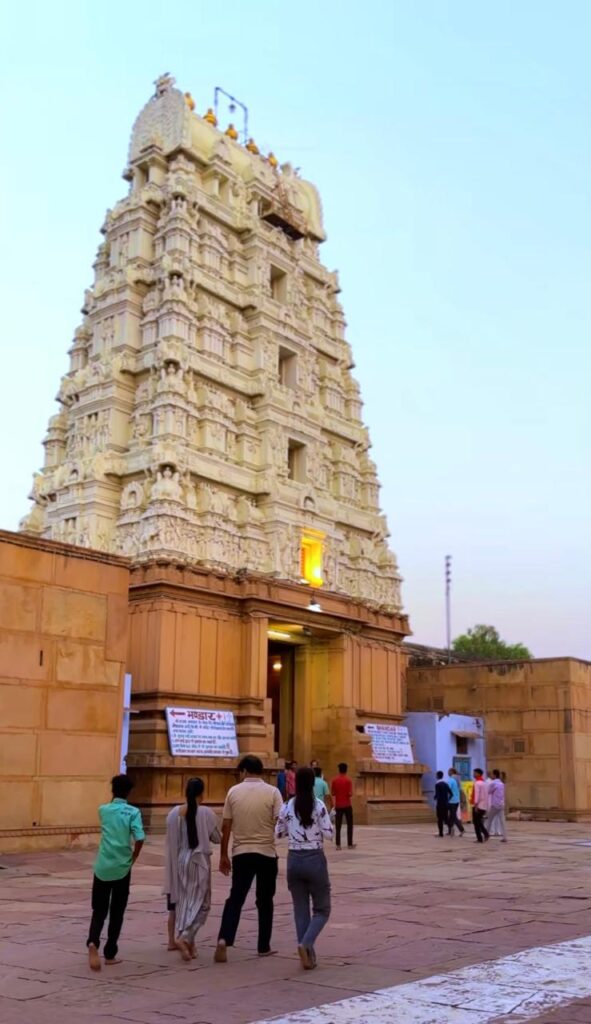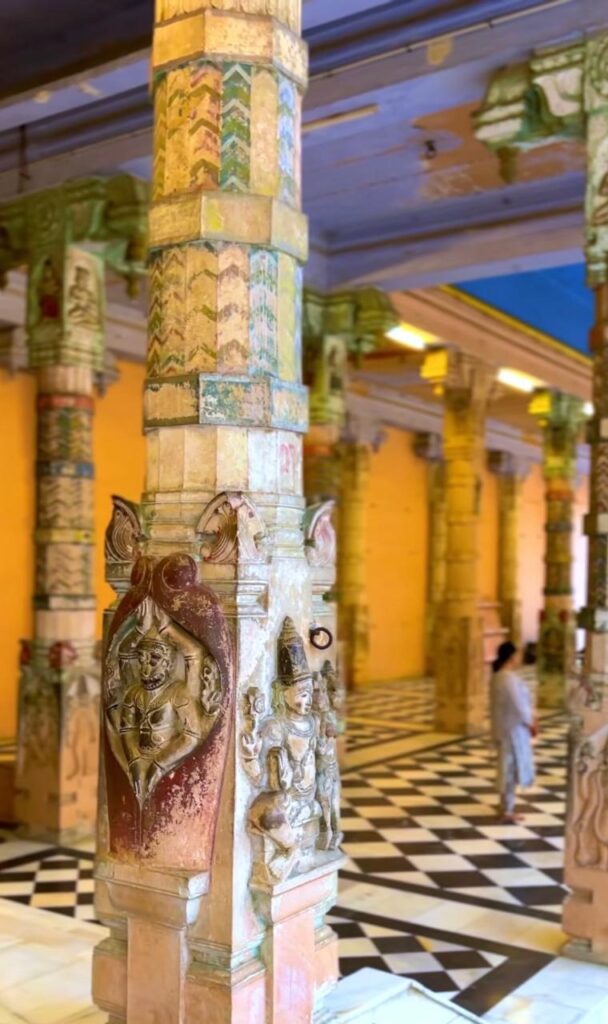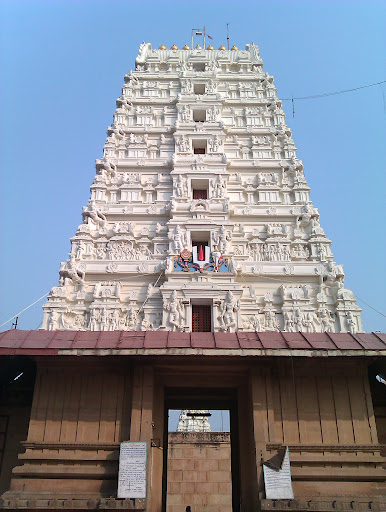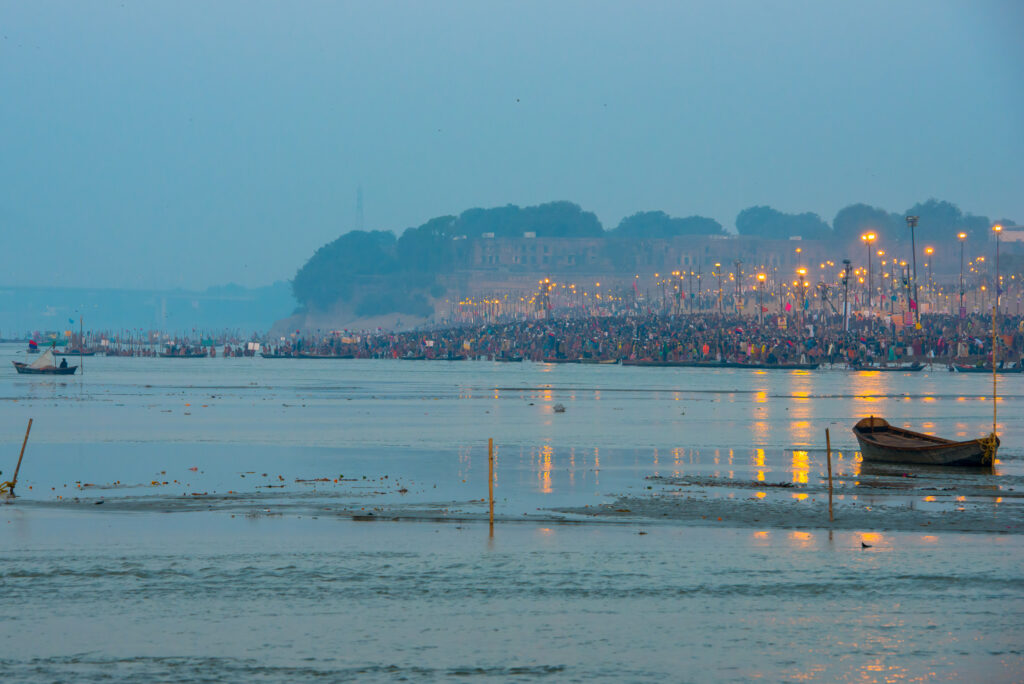The Sri Ranganatha Swamy Temple, popularly known as Rangji Temple, is one of Vrindavan’s most architecturally distinct and spiritually significant landmarks. This temple is unique because it beautifully blends North and South Indian temple styles, making it a must-visit for travelers and devotees alike.

History and Legend
- The temple was constructed in 1851 by Seth Govind Das and Seth Radhakrishna, prominent merchants from Chennai who were inspired by South Indian traditions.
- It is dedicated to Lord Ranganatha, a reclining form of Lord Vishnu, lying on the sacred serpent Adishesha.
- The presiding deity is accompanied by the idols of Goddess Lakshmi, Lord Krishna, and Garuda (the eagle mount of Lord Vishnu).
The temple’s establishment aimed to bring South Indian Vaishnavite traditions to North India, making it a cultural confluence of the two regions.
Architectural Grandeur
Rangji Temple’s design stands out among the predominantly North Indian-style temples in Vrindavan. It is an exceptional example of Dravidian and Nagara architectural styles combined.

Key Features:
- Gopuram: A towering entrance gate reminiscent of South Indian temples. The intricate carvings and sculptures depict scenes from Hindu mythology.
- Garbhagriha (Sanctum Sanctorum): The sanctum houses the beautiful idol of Lord Ranganatha, elaborately decorated with gold and flowers.
- Prakaram (Circumambulatory Path): Surrounding the sanctum, this path allows devotees to offer prayers while walking in a clockwise direction.
- Pushkarini (Temple Tank): A large water tank in the temple premises, used for various rituals.
- Rajagopuram: The temple also features a majestic Rajagopuram, a multi-tiered gateway typically seen in South Indian temples.
The temple’s large courtyards, sprawling corridors, and carved pillars create an aura of divine tranquility.

Religious Practices and Celebrations
Rangji Temple follows rituals and practices aligned with the Sri Vaishnavism tradition, which is prevalent in South India.
Unique Rituals:
- Brahmotsavam: A grand 10-day festival celebrated annually in March-April, attracting devotees from across the country. During this festival, the idols are carried in a beautifully decorated chariot through the streets of Vrindavan.
- Daily Aartis and Poojas are performed in the temple, blending North and South Indian rituals.
- The temple offers prasadam (holy food) to visitors, which is both spiritually and gastronomically enriching.
Spiritual Significance
- Rangji Temple represents the harmonious coexistence of different cultural traditions, bridging the gap between South Indian and North Indian devotional practices.
- The temple’s serene ambiance makes it a favored spot for meditation and reflection, away from the hustle of Vrindavan’s crowded streets.
Best Time to Visit Rangji Temple
- Morning Hours: Experience the calmness of the temple during early morning darshans.
- Festival Time: Brahmotsavam is a spectacle not to be missed, with vibrant decorations, cultural performances, and special rituals.
- October to March: The cooler months provide a comfortable climate for exploring the temple and surrounding areas.
Tips for Visitors
- Footwear Policy: Like most temples, footwear is not allowed inside. Ensure you leave them at the designated counters.
- Modest Attire: Wear respectful and traditional clothing while visiting the temple.
- Guides: Hire a local guide to understand the temple’s rich history and cultural significance.
- Photography: It’s best to check beforehand if photography is permitted, as many temples have restrictions.
Nearby Attractions to Explore
After visiting Rangji Temple, consider exploring these nearby spots:
- Banke Bihari Temple: Just a short distance away, this iconic temple is a must-visit.
- ISKCON Temple: Known for its serene environment and kirtans.
- Prem Mandir: A modern marvel with stunning light displays.
- Govind Dev Ji Temple: Another architecturally stunning temple in Vrindavan.
Why You Should Visit Rangji Temple
Rangji Temple offers a rare blend of architectural splendor, spiritual energy, and cultural richness. Whether you’re a history enthusiast, an art lover, or a devotee seeking divine blessings, this temple caters to every kind of traveler. It’s not just a place of worship but also a testament to India’s diverse and unified cultural heritage.
If you’re visiting Vrindavan, make Rangji Temple an essential part of your itinerary to immerse yourself in its serene beauty and profound spirituality.


